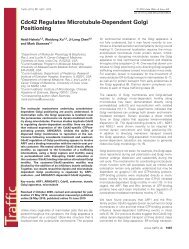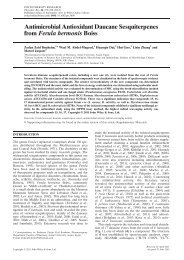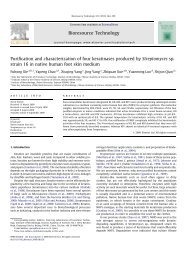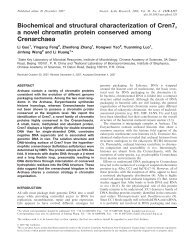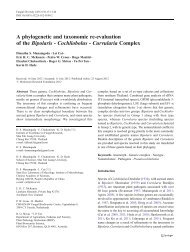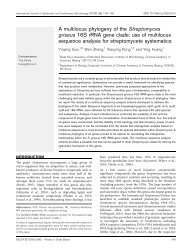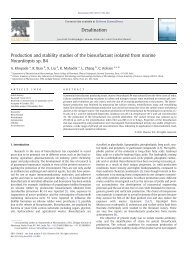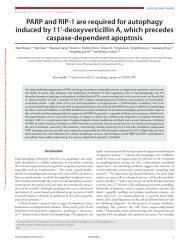Expression of cefF signiWcantly decreased deacetoxycephalosporin ...
Expression of cefF signiWcantly decreased deacetoxycephalosporin ...
Expression of cefF signiWcantly decreased deacetoxycephalosporin ...
You also want an ePaper? Increase the reach of your titles
YUMPU automatically turns print PDFs into web optimized ePapers that Google loves.
J Ind Microbiol Biotechnol<br />
reduce the contamination <strong>of</strong> DAOC, an attempt <strong>of</strong> adding<br />
an extra copy <strong>of</strong> cefEF gene in A. chrysogenum made a<br />
40–70% reduction in the DAOC level [6]. In this report, we<br />
have demonstrated that the S. clavuligerus hydroxylase<br />
gene (<strong>cefF</strong>) could function quite well in A. chrysogenum<br />
and successfully reduced the content <strong>of</strong> DAOC in the CPC<br />
fermentation broth. This work also showed a great possibility<br />
to reduce the cost <strong>of</strong> CPC puriWcation by improving the<br />
industrial strain through this way.<br />
Materials and methods<br />
Microbial strains and media<br />
Escherichia coli TOP10 was purchased from Transgen<br />
(Beijing, China) and used for plasmid construction. The<br />
cephamycin-producing strain Streptomyces clavuligerus<br />
CGMCC4.1611 was obtained from China General Microbiological<br />
Culture Collection Center (CGMCC). Micrococcus<br />
luteus CGMCC 1.1848, a β-lactam antibiotics-sensitive<br />
strain, was used as the indicator. The wild-type strain Acremonium<br />
chrysogenum CGMCC3.3795 was used as a host<br />
for DNA transformation and for producing cephalosporin<br />
C. Agrobacterium tumefaciens (updated scientiWc name:<br />
Rhizobium radiobacter) AGL-1 was provided by Pr<strong>of</strong>essor<br />
Xingzhong Liu (Institute <strong>of</strong> Microbiology, CAS).<br />
Escherichia coli and A. tumefaciens were grown in Luria<br />
broth (1% sodium chloride, 0.5% yeast extract, and 1% tryptone)<br />
or Luria broth agar. MM/IM/CM media were used in<br />
A. tumefaciens-mediated transformation [4, 17]. To isolate the<br />
genomic DNA, S. clavuligerus was grown in liquid TSB<br />
medium (Becton–Dickinson, Franklin Lakes, NJ) in a shake<br />
Xask at 28°C for 2 days. A. chrysogenum was incubated on<br />
TSA agar (1.7% tryptone, 0.3% tryptone soya broth, 0.25%<br />
glucose, 0.5% sodium chloride, 0.25% K 2 HPO 4 , and 1.5%<br />
agar) for growth. For sporulation, A. chrysogenum was cultured<br />
in LPE agar (0.1% glucose, 0.2% yeast extract, 0.15%<br />
sodium chloride, 1% calcium chloride, pH6.8, and 2.5% agar)<br />
at 28°C for 7 days. For fermentation, Wve plates <strong>of</strong> spores were<br />
collected and suspended in 2 ml <strong>of</strong> distilled water and then the<br />
spores were inoculated with 100 ml <strong>of</strong> seed medium in a 500-<br />
ml Xask on a 250-rpm rotary shaker at 25°C for 2 days [28].<br />
Then, 10 ml <strong>of</strong> seed culture was used to inoculate 100 ml <strong>of</strong><br />
deWned production medium (MDFA) in a 500-ml shake Xask<br />
[28]. These cultures (duplicate) were incubated in a rotary<br />
shaker at 25°C for 7 days. Production <strong>of</strong> β-lactam antibiotics<br />
was measured by bioassay against M. luteus CGMCC 1.1848.<br />
Plasmid construction<br />
Primers 5-gactagtGTGGATGGCACCTTTTGGG-3 and<br />
5-cggcgcgccGGTGACGGTTTGTCCTGCC-3 (SpeI and<br />
AscI sites were underlined) were used to amplify the promoter<br />
region (1,188 bps) <strong>of</strong> pcbC using the genomic DNA<br />
<strong>of</strong> A. chrysogenum as a template. Primers 5-aggcgcgcc<br />
CGAAGGAGCAGGGGAACA-3 and 5-ccctgcagg<br />
CGGCTTGAATGCAACGAC-3 (AscI and SbfI sites were<br />
underlined) were used to amplify <strong>cefF</strong> (1,091 bps) using the<br />
genomic DNA <strong>of</strong> S. clavuligerus as a template. Those<br />
ampliWed DNA fragments were ligated into the cloning<br />
vector pEASY-Blunt (Transgen, Beijing) and sequenced<br />
(Invitrogen, Shanghai) to verify their accuracy. Then, the<br />
DNA fragments were digested with the designed enzymes<br />
and ligated into the corresponding sites <strong>of</strong> pAg1-H3 [32]<br />
which was previously digested by SpeI/SbfI to generate the<br />
plasmid pAg1-H3-<strong>cefF</strong>.<br />
Agrobacterium tumefaciens-mediated transformation<br />
The plasmid pAg1-H3-<strong>cefF</strong> was introduced into the competent<br />
cells <strong>of</strong> A. tumefaciens AGL-1 via heat shock transformation<br />
[10, 15, 16]. One transformant was selected<br />
randomly and grown in MM at 28°C for 2 days at 250 rpm.<br />
The cultured cells were diluted to 0.15 <strong>of</strong> OD 600 in IM and<br />
incubated at 28°C for 6 h (OD 600 reaches 0.6) at 250 rpm.<br />
Mix 100 μl <strong>of</strong> the cultured cells with 100-μl suspensions <strong>of</strong><br />
dispersed A. chrysogenum spores (1 £ 10 7 spores per ml)<br />
and spread the mixture on CM agar plate. The mixture was<br />
incubated at 25°C in the dark for 3 days and transferred to a<br />
TSA agar plate supplemented with 50 μg/ml hygromycin B<br />
and 200 μM <strong>of</strong> cefotaxime. Colonies <strong>of</strong> hygromycin<br />
B-resistant transformants were selected after cultured at<br />
28°C for 4 days.<br />
Quantitative PCR<br />
Genomic DNA <strong>of</strong> A. chrysogenum was isolated by the phenol–chlor<strong>of</strong>orm<br />
method [2]. Absolute quantiWcation was<br />
performed to quantify the <strong>cefF</strong> copies <strong>of</strong> transformant<br />
using Mastercycler ® ep realplex equipment (Eppendorf,<br />
Germany) and SYBR ® Premix Ex Taq II PCR kit<br />
(Takara, Dalian). Standard curve <strong>of</strong> absolute quantiWcation<br />
was created by seven orders <strong>of</strong> magnitude dilution series<br />
(10 ¡1 to 10 ¡7 dilution) in triplicate <strong>of</strong> the water solution <strong>of</strong><br />
pAg1-H3-<strong>cefF</strong>. Samples were analyzed in triplicate from<br />
1/100–1/200 dilution <strong>of</strong> the original PCR product. Primers<br />
5-ACGTCGAGCGTCTTCTTCCT-3 and 5-TTCTTC<br />
GCGTGCATGGTG-3 were used in this experiment. Then,<br />
2 μl <strong>of</strong> diluted template DNA, 9.5 μl <strong>of</strong> water, and 0.5 μl<br />
each <strong>of</strong> the primers were added to 12.5 μl <strong>of</strong> PCR mix and<br />
subjected to 40 cycles <strong>of</strong> PCR (5 s at 95°C and 30 s at<br />
65°C). Melting curve analysis after the cycling conWrmed<br />
the absence <strong>of</strong> non-speciWc products in the reaction. The<br />
Xuorescence threshold (Ct) values were calculated for standards<br />
and samples by using the realplex s<strong>of</strong>tware.<br />
123





